This was a busy day for me. I started by taking a taxi out to the north of St. Petersburg, intending to visit the flea market first thing, hoping to finish the minimal shopping I had started in Moscow. My AI source assured me that it was open every day. It was not. And so I found myself in the outlying reaches of the city, where, due to my inflamed and blistered ankles, every step was painful. But, I was there for a reason, it seems.
There was a forested area across the street from the upper end of the flea market area, and in the edge was nestled the perfect traditional Russian wooden church. The grounds included another wooden building, suggesting, perhaps, a small monastic presence. A gardener was working in the flower beds. Incongruously, there was a pedestal enclosed within a fenced area, with what appeared to be a bust of Tsar Alexander III. I was fascinated by what I had stumbled upon by accident, on exactly no one’s St. Petersburg itinerary.
The church was locked, so I was not able to see inside, but was content with soaking up the peace without. As I was leaving, I stopped to try and translate the sign. I am beginning to be able to make rough translations from Russian signs. I discovered, with great excitement, that this was the Church of St. Pantaleimon the Healer. I say with excitement, because St. Panteleimon had been with me the entire trip.
Back in 2014, I was in Batumi, Republic of Georgia. That Sunday morning, I went with Poti and Soso to the Transfiguration Church, high in the hills overlooking the city. After Liturgy, the priest gave me a small, hand-painted icon of St. Panteleimon, which I have treasured ever since. It is the one icon that I take with me on my travels, setting it up in my room as a makeshift prayer corner.
In visiting the Church of Christ the Saviour in Moscow, the icon that I was drawn to was that of St. Pantaleimon. And the icon I purchased in the church shop–the only one in Moscow–was that of St. Pantaleimon. I briefly stepped inside the Church of St. George, outside the Victory Museum in Moscow. The only icon I remember there was of St. Panteleimon. And so, he had been with me every step of the way.
It began to dawn on me that I was in need of physical healing, for starters. And so, then and there, while awaiting the taxi I had summoned, I began to pray for the intercession of St. Panteleimon the Healer. Over the course of the day, I received relief from my physical infirmity, but more importantly, spiritual refreshment. Back in the hotel room, I researched the church. It dates to 1870, and was consecrated in 1871 by Tsarevich Alexander (later Alexander III). It served the psychiatric hospital that he had established on the grounds. It was closed by the Soviets in 1929, and suffered from years of neglect. It was returned to the Church in 1990.
I took a taxi from there to the Monastery of St. John of Kronstadt, a somewhat “modern” saint, who died in 1909, I believe. His Christian name was after St. John of Rila, as is mine. I was able to venerate his relics, and was blessed by a priest afterwards. Again, before leaving the underground chapel, I noticed another icon of St. Pantaleimon. I made some modest purchases in the church shop, including an English-language hagiography.
From this monastery, I taxied to Smolensky Cemetery, on one of the islands. In the midst of the forested necropolis, stands a small chapel housing the relics of St. Xenia of Petersburg. Here, I stood in line for about two hours, inching slowly forward. Many of the pilgrims were bringing flowers, and of course, their prayer requests.
After St. John of Kronstadt and St. Xenia, I taxied to the Alexander Nevsky Lavra, where the relics of Russia’s great national hero rest. Catherine the Great constructed an enormous silver sarcophagus, which is, unfortunately for me, now behind a screen where there is restoration work underway. But I enjoyed my time here, and even purchased a small icon of St. Alexander Nevsky, as well as an icon card or St. Febronia and St. Peter, Russian saints whose stories resonate with me. And again, there was a wonderful icon of St. Pantaleimon within the church. I reflected that somewhere along the way, I had stopped concentrating on my ankles, and now walked somewhat normally.
Across a canal from the Lavra, is the Tikhvin Cemetery. This was a destination for me as well. My first stop here was the grave of Dostoevsky. There were some benches in front, and the Russian visitors did not just stroll by, but stopped here and contemplated their literary genius. As did I. “Beauty will save the world.” Further around the small cemetery is a row of some of Russia’s great composers: starting with Rimsky-Korsokoff, then Mussorsky, then my favorite-Borodin, and finally, Tchaikovsky. I paid my respects, then taxied back to the hotel.
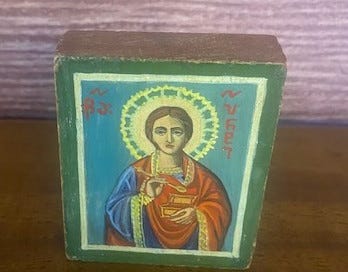





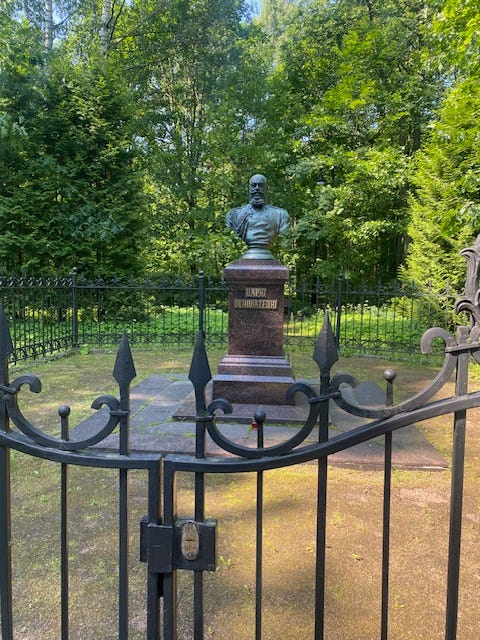
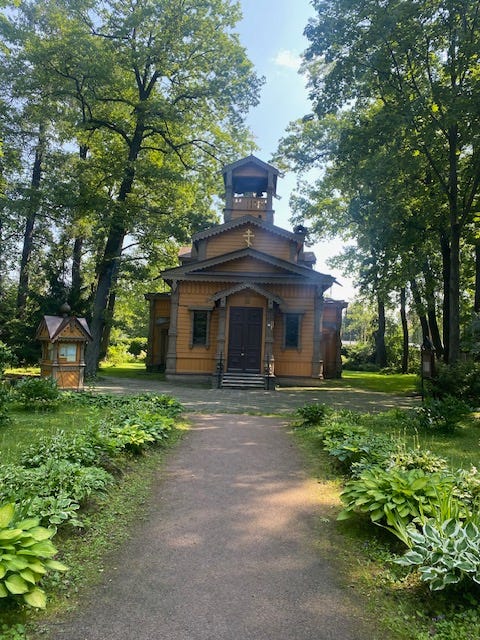
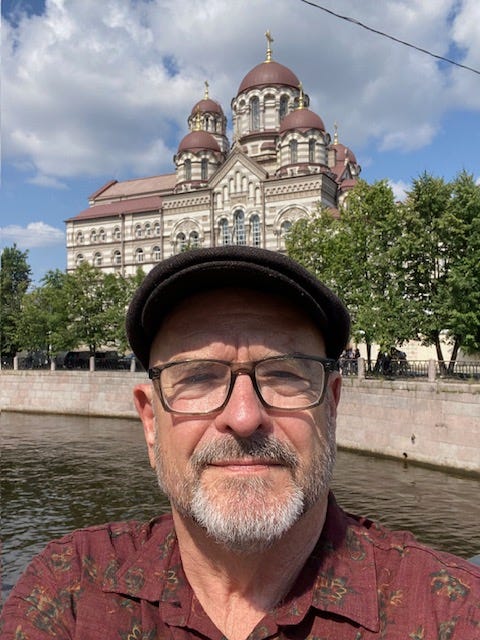
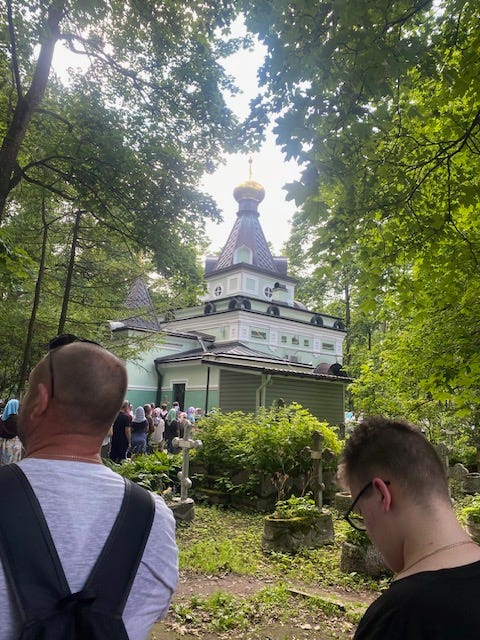

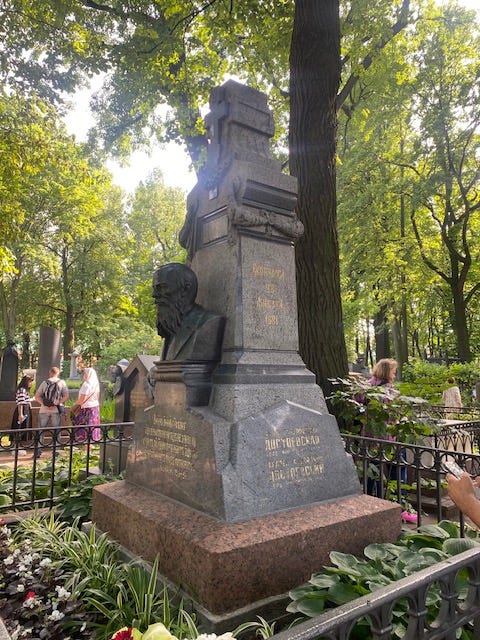

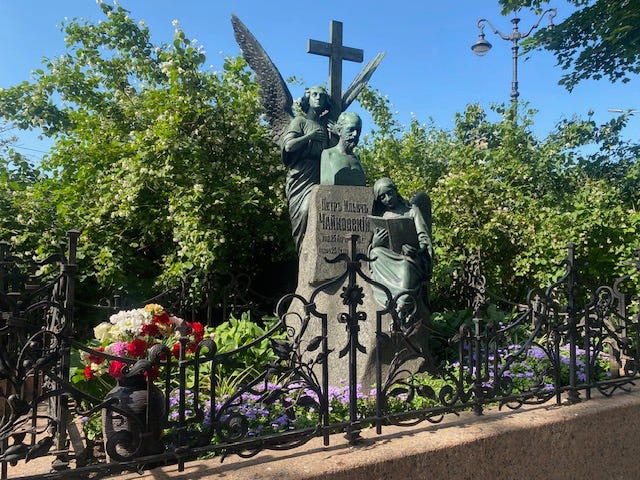
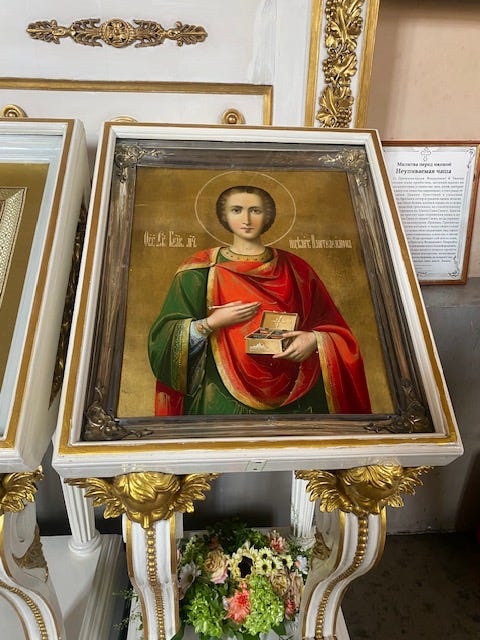
Thanks for enabling us to share in your pilgrimage.